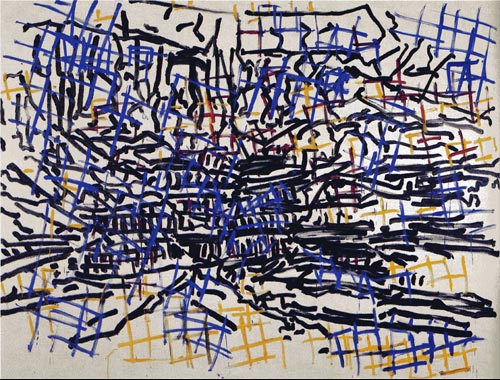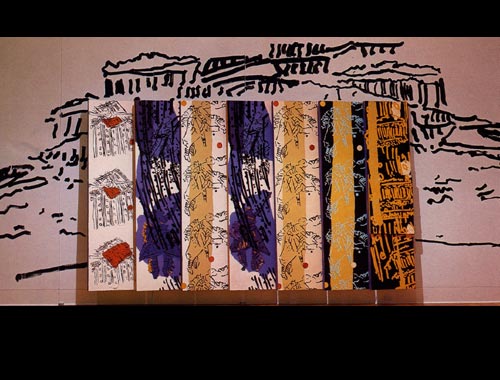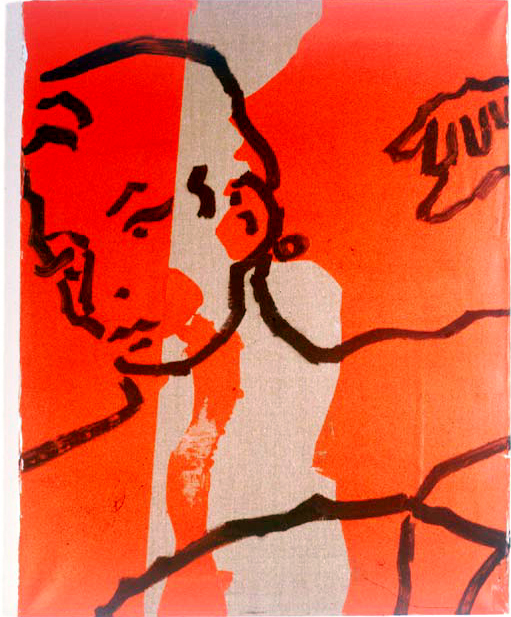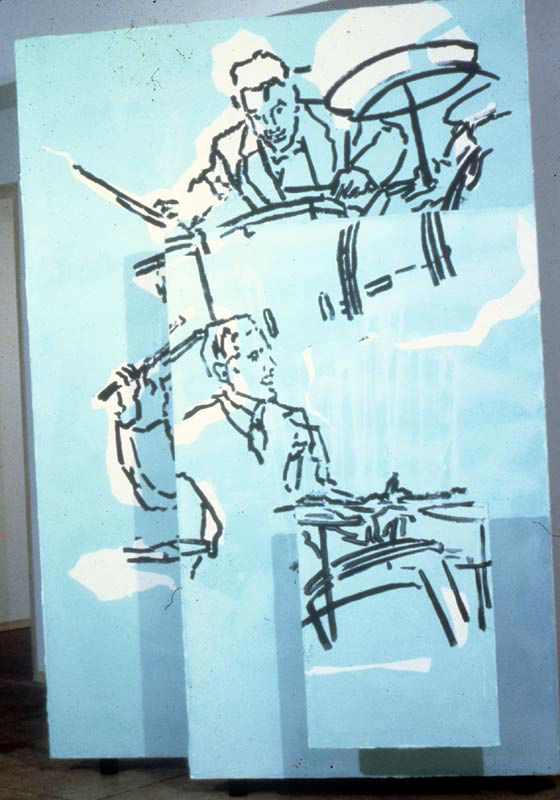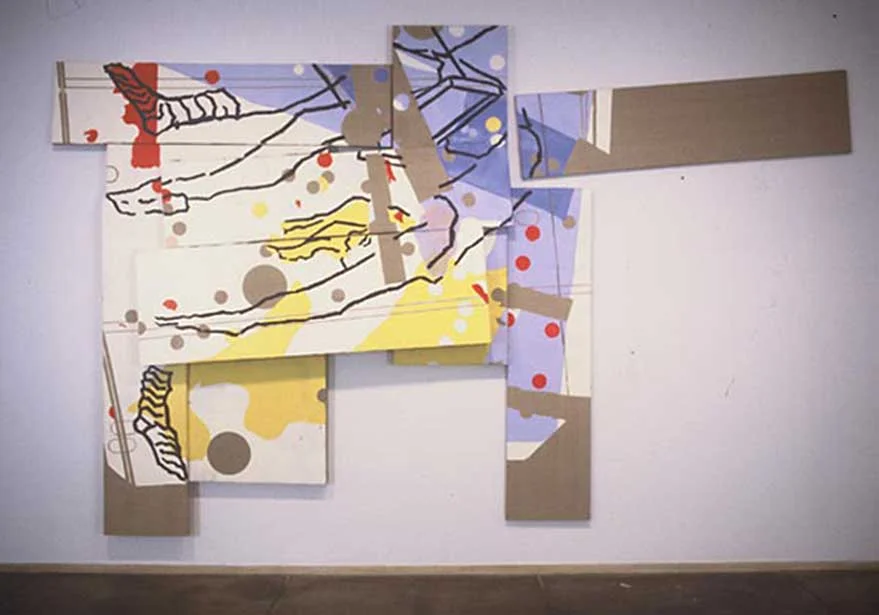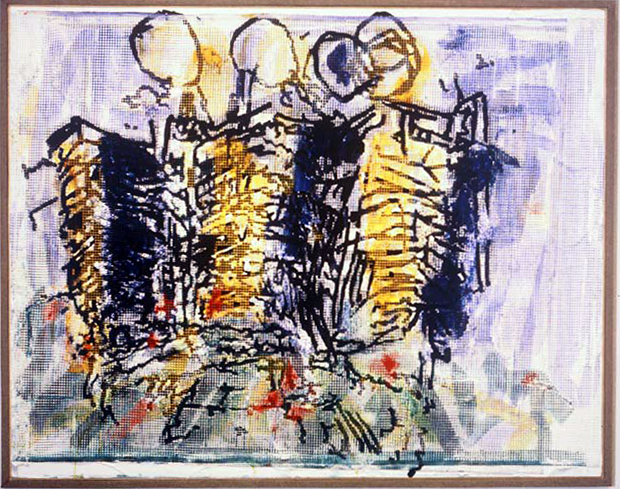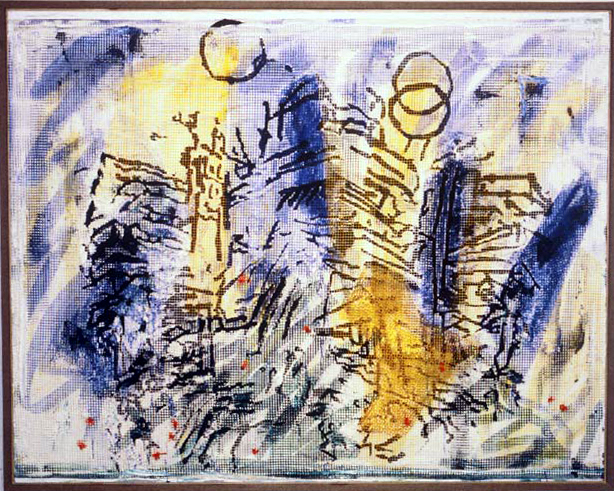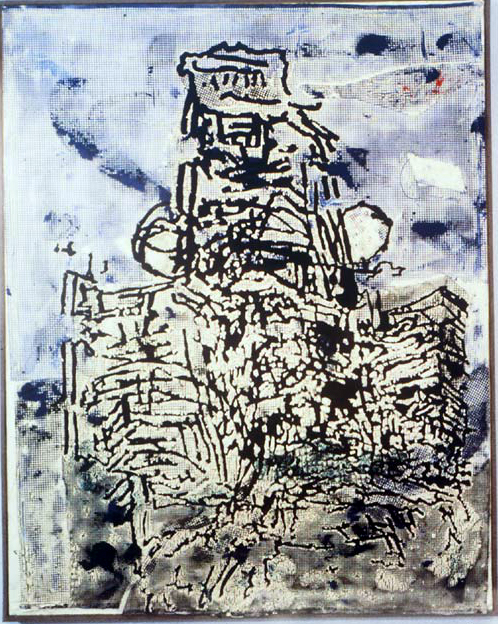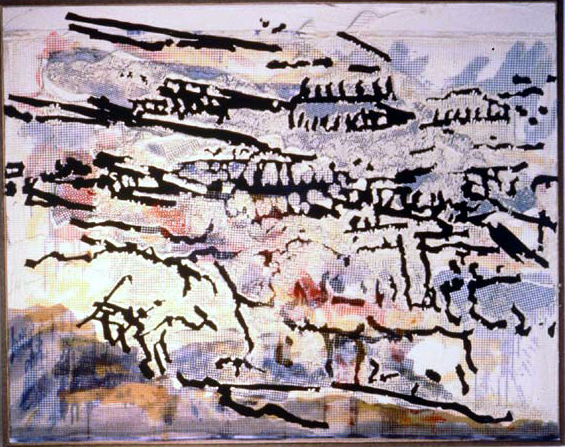Supposedly, the modern urban consciousness has an atomized character, although those who belabor the fact sometimes betray a desire for reassuring uniformity, with everybody contentedly, domestically alike and all the commuter trains running on time no matter what. To an outlook threatened by the lively and spontaneous, by signs of creative animation and prospects of free growth, nothing could be more different from all our reassuringly clinical, belated Constructivist sculptures sitting mute and sphinxlike in the plazas of antiseptic office buildings than Judy Rifka's utterly agitated paintings. But Rifka's wit, which luckily keeps up with her anxious agitation, entails putting high care into a "careless" look. And in a world charged with contending impersonal forces, this is like advertising in reverse, "pushing" the individual consciousness in all its brave fragility.
"Individualism," per se, has its own limits and its functions, including safely Utopian dreaming. If much is often made of the raucously iconoclastic "Punk" music which drew in young New York painters at the turn of the 1970's, the "high-culture" revival by the Metropolitan Opera of Bertolt Brecht and Kurt Weill's Rise and Fall of the City of Mahagonny (1930), in November of 1979 is equally symptomatic of the frustration, but also a certain outsider artworld camaraderie, of the time. Not unlike Brecht's opera, Rifka's truly iconoclastic paintings suggest that Utopias come cheap, which it may be responsible rather than necessarily cynical to face up to. That, after all, idols are for shattering, pertains generally to Rifka's work as I see it, to her single, smaller canvases having one "unscrewed" image on its own as well as to her "big-band" muralistic works, those sweeping cascades, Niagaras to be as hyperbolic as they are of images fragmented and “atomized."
Rifka's is so distinctly an urban art that, in its most characteristic aspect, it may not travel well, except from one downtown to another. For one thing, city culture has had a bad name in America from Puritanism onward, though it has become easier for outsiders to tune in, at least on a level of caricature, thanks to the media. Given the daily experience of an open landscape, true city art must look pinched the opposite, for us in the big town, being the void evoked by all the moaning songs about truck drivers abandoned in trailers by waitresses. Seriously: it is too easy to forget that the weight of European culture, ever since the rise of the medieval market town (of which Los Angeles may be a gigantic survival), has rested on the sheer human density of life in the capital and that this has been by no means unfortunate for cultural life. I notice in the Introduction to the Devout Life (1609) of St. Francis deSales a suggestion for a rather vivid meditation onhell as "a gloomy city burning with sulphur and foul-smelling pitch and filled with people who cannot escape from it." All the more because Francis goes on to evoke as the opposite a landscape vision of heaven's sky in beautiful night and day, it is easy to jump to the false conclusion that he is evoking first the (bad) city and, at that, in terms that anticipate even Frank Lloyd Wright's caustic jibes at New YorkÑ and then the (good) country, whereas he actually assumes that the beautiful sky and light are urban, pertaining to, yes, Jerusalem (I.15f, trans. J. K. Ryan).
Georg Simmel, the philosopher and founder of modem sociology, says much in a lecture on "The Metropolis and Mental Life" (1902-03) that illuminates Rifka's art as fundamentally urban and, here and now, of the New York moment. First comes the itchy unanchored agitation so characteristic, no doubt, of the modem cultural capital itself. Speaking of how the city encourages an intellectual and quantitative, rather than sentimental, consciousness, Simmel holds that "the psychological basis of the metropolitan type of individuality consists in the intensification of nervous stimulation which results from the swift and uninterrupted change of outer and inner stimuli. . . . " It's not merely the pace, but the expenditure of attention and response: "Lasting impressions, impressions which difer only slightly from one another, impressions which take a regular and habitual course and show regular and habitual contrasts all these use up, so to speak, less consciousness than does the rapid crowding of changing image, the sharp discontinuity in the grasp of a single glance, and the unexpectedness of onrushing impressions" (emphasis his). We are accustomed to such an essentially urban consciousness as manifest in the Impressionists' painting of the hustlebustle of nineteenth-century Paris, and even, in a more abstracted way, in relation to Mondrian's "boogie-woogie" vision of New York in the 1940s. What Rifka's jumpy images expose is a still edgier, more anxious and testy, late-twentieth century version of the same mentality.
Where Simmel speculates on the far-reaching chaos that would ensue if all the clocks ol Berlin were stopped for a single hour, I am reminded of a remark made by Edit de Ak, the New York art critic who has done so much to relate the work and world of the real subway "graffiti" artists, and related "Punk". musical culture as well, to the New York artworld. Describing how difficult it is to keep moving on both fronts at once, de Ak commented that the time-consuming "hanging out" entailed by discourse in the one sphere is bound to be shattered by the clock- dominated, business life of the city, so that, after "hanging out" for, maybe, three days with the young outsider artists, she would have to break off contact at an inevitably promising point in order to keep, just late enough to manage, some mainstream appointment. Historically, one might even think of Baudelaire, in the nineteenth century, who, as Walter Benjamin points out, maintained apartments in three different neighborhoods of Paris at once!
Interesting, too, in light of the rootless "float" of Rifka's human figures, which might be taken as acquiescently bobbing around in a gravity-free space, is Simmel's conception of the "blase" attitude that marks the modem city dweller. For in a life structure "of the highest impersonality" what develops is "a highly personal subjectivity" at the heart of the defensive or even aversive urban personality. Today, Simmel's pseudophysiological terms may sound quaint, and amusingly so, yet his thought is nevertheless telling: "The blase attitude results first from the rapidly changing and closely pressed contrasting stimulations of the nerves. From this, the enhance- ment of metropolitan intellectuality, also, seems originally to stem. Therefore, stupid people who are not intellectually alive in the first place usually are not exactly blase." Even hectic, Baudelairean nightlife has its part in this, including even, by extension, ear-splitting rock music nowadays: "A life spent in boundless pursuit of pleasure makes one blase because it agitates the nerves to their strongest reactivity for such a long time that they finally cease to react at all." Battered by otherwise "harmless impressions," the nerves are torn "so brutally hither and thither that their last reserves of strength are spent, and if one remains in the same milieu they have no time to gather new strength." This results, as Simmel sees it, in "an incapacity... to react to new sensations with the appropriate energy," just what "constitutes that blase attitude, which, in fact, every metropolitan child shows when compared with children of quieter and less changeable regions."
(trans. K. H. Wolff in his collection The Sociology of Georg Simmel, 1950). Pop Art, psyched -i; urban if not urbane, brought fast city culture and its "lifestyles" (the term was used by Schopenhauer, not that there was time to notice) to the artistically conscious surface. However, Rifka's fitful shifts of attention from one theme to anotherÑa bunch of these, then a bunch of thoseÑamount not to a passively reflected contemporary dizziness but to a more dogged stalking of the fickle and elusive modem consciousness in its very agitation. More than Andy Warhol, who was content by and large with impassive registration, Rifka goes after and nails down the sprinting temper of the time, bagging it, as it were, not just taking bird-watcher's notes. Because the emotive texture of her work is so honestly, defensively ironic, "streetwise," and because in her judo-like, flexible (instead of flexing) strength there is a feminism so clear as to be transparent (and as such almost unnecessary to remark), she shares something of what must have been the polite sass of the prolific Rosalba Camera, in the eighteenth century, at least in a quip by that painter that strikes me as more Rifkaesque than Warholean: "I am charmed with every thing I do, for eight hours after it is done!" (this as quoted in the once famous "Mrs.," i.e. Anna, Jameson's Sketches of Art, Literature and Character, 1866).
Rifka's work is embraced with delight by the aware young, even if, to put it in New-Yorkese, these kids today don't know from history. Andy Warhol is somebody they encounter in art history classes. Understanding this concerns Judy Rifka's work fundamentally. Far from regressing into a childish realm, safe from fuller consciousness, her painting assumes its historical weight so ably that I imagine it -as downright educational for the kids themselves, whose own dilemmas they might well have thought inarticulable even though, since the Beatles, their fraternity is effectively worldwide. No art that simply mirrored the way things are could be as capable as Judy Rifka's of crossing a definite line of consciousness and then also managing to re-cross it, reporting back from what to most adults might as well be Oz.
Popularly, there is in high-to-late industrial culture a premium on expert invention in the sense of coming up with the workable new trick, with the special gleam of fine art reserved as a consolation prize for moral drabness and conformity. Thus even the grand Victorian phrases, all sort of upholstered in mohair (practical and elegant), with which Carlvie toasts "The Poet as Hero" (in On Heroes, Hero-Worship and the Heroic in History) can begin to sound like the poet or artist as tycoon in a marketplace of things warmingly "spiritual," or even as a mere "star," one who has found a way to "make it" at some mass-marketed "game" that requires its quantum of upbeat "sincerity." Rifka gets into this through her assumed posture of offhandedness, inadvertency, insofar as that appears as an actÑnot phony, either, but an act as such, her “number."
What would it mean to say that Rifka's posture is no pose? At one extreme, that the artist "couldn't help" producing her art as the result of a certain syndrome, helplessly, even pitiably (Arbus); at the other, that the artist was such a dandy as somehow "genuinely" to be all pose, with art as a pseudo-natural by-product (Warhol). The trouble is that both can be "acts" and marketable as such, especially in a populistic American way. For example, the cartoons of Peter Arno are an "act," broadcasting within commoner cultural life, and with a lightness that cannol threaten but can only assuage, a drawing style developed with committed passion in German Expressionism by Ernst Ludwig Kirchner and which originally had deep roots in consciousness. Rifka's outright accessibility differs from the populism of an Amo, however, precisely because it encourages a consciousness of superficiality as such, and that is not a superficial thing. Oscar Wilde might have seen this as victory of the critical, over the creative, intelligence; vet there is its ultimate genuineness as art, something more than a theatrical spin-off of pose.
That the leveling, democratic American temper that Wilde himself found bracing here, at least for a few weeks (!), also charmed later European modems, pertains historically to Rifka's art. For one thing, her picture structure sustains a post-Cubist jumble that is, as Theodore Roosevelt might have noted in his famous critique of the 1913 Armory Show, not so unlike that of the "crazy quilt" so symbolically American as well as female and domestic (but also feminine-collective), despite its sources in European folk art. Even Rifka's high-art "appropriations" of the image of the Parthenon, touching base with the European classical tradition at its most hallowed point, are as utterly American as the home-grown "Parthenon" of Nashville, which in the most literal way is sportier, in so much better "shape," than its long infirm European model. Besides, what could be more gutsily wrong-headed than the way the Nashville building (an art museum and hence an unashamed "temple of culture") doesn't mind being parked as it is, like some big '50's sedan, on a flat lot in the world's capital of popular country-and- westem music? Most like Rifka's art must be the sense of doing "it," naive or not, anyway, maybe even doing a whole bunch, as Rifka has actually done with the Parthenon image in her "Museum" paintings. Yet even more important, I should add in a hurry, is the real cosmopolitanism that this art may belie (shucks).
Rifka's painting is altogether in tune with the interest taken by earlier modern European artists in just such American esprit, especially in regard to New York. The cultural importance of New York as the big home town of American art deserves more understanding in a suburbanized Post-War America. It may seem incredible, but when we "war babies" were born, something like 6% of the entire population of this country lived within the City of New York. This city that epitomized urban excitement to everybody from G. K. Chesterton—who said the neon signs of Times Square would look wonderful if one couldn't read English (my chauvinistic grandfather included these in his periodic tours, but tried to drive by fast enough so that we kids couldn't read them)—to Mondrian—who took up boogie-woogie —was a floating congress for everybody with ideas and, well, gumption. Bostonians may have said crude ambition, jealously enough, after the pubishing industry moved to New York in the nineteenth century; yet there is a beautiful early photograph by Steiglitz of Manhattan, with the smokestacks of buildings and ships steaming away, just arrogantly-enough entitled City of Ambition.
Stuart Davis's New York to Paris, No. 1, painted in 1931 (University of Iowa, Museum of Art), has transatlantic cultural contact with the jivey Paris of Leger as its overt theme. In a hurry and jumble that anticipate Rifka, Davis intertwines a fishing boat with nets, a New York "el," a cliche-Parisian cafe, telegraph pole and wire, the Chrysler Building and a luggage tag hanging down into the cheerfully reckless "composition." This whole cluster of emblematic items is dominated by a big, sassy, silhouetted, American-in-Paris "gain," to recall a popular term of the time of World War II, strutting by in stocking and high-heeled shoe. In the next decade, the war itself displaced major artists, among them Duchamp and important Surrealists but also Mondrian, to New York, where, within a few years, American painting would for the first time challenge and even exceed the centuries-old artistic claims of Europe. Already here, however, in 1931, with Stuart Davis being so American even in "grooving on" Paris, is an intimation of Rifka's rather more anxious and fretful urban jitterbugging. Not that everything is quite that simple or causal: in a subtler way in Rifka's work of only a few years ago, even the Abstract Expressionism of the booming postwar years reverberates, notably in a kind of twirling drawing-in-paint apparent in, especially, latterday works by de Kooning. Yet, without being deterministic, Davis's painting does offer one way "into" Rifka's altogether "nowsville" art.
The various multiple images that flit so seemingly irresponsibly, or with anesthetized disengagement, across so many of Rifka's canvases, come from a "stock" of sorts. They are so distilled, in the processes of being drawn on transparent acetate sheets and then jiggled around in opaque projection for placement as forms in the painting, and too digested, as such, to amount to simple "appropriations." What they do have in common with an esthetic of "appropriation" prevalent todav is their air of being initially "pulled down," rather than elevated, in the hierarchy of images: unlike the high-culture appropriation of primitive and folk arts, early in the century, many an imagery of mass distribution is now borrowed from the technical realms of the media, including television (we hear much of this) but also the visual parlance of slickly calculated advertising. Such is a broadcast imagery in the root sense, one scattered far and wide. Appropriating becomes an issue of qualifying the sometimes almost magically authoritarian character of images as coming from on high, that is, from the same high stratum, ironically enough, in which works of fine art stand as special tokens of cultural ultimacy.
In a way, this advances a lactic first pursued less critically by the Pop artists of twenty years ago, as when Roy Lichtenstein took over comic-book imagery and transformed it "abstractly" into high art. And now that appropriation has a sharper critical thrust, Henri Zerner's discussion of Lichtenstein's Bobby Kennedy cover from Time magazine (in the catalogue of an exhibition on The Graphic Art of Roy Lichtenstein in the Fogg Art Museum, at Harvard University, in 1975) seems keen: Zerner points out that the Time cover, for which, significantly, Lichtenstein made the color separations himself, is, even though it constitutes an edition in the millions, "more of an original print than so many Braque or Chagall lithographs that are merely gouaches skillfully reproduced by professionals and signed by llic master. Now one might think, further, of Rifka's generative use of drawings on transparent acetate sheets in analogy with the reproductive transparencies of Lichtenstein's color separations, in which sense she makes "monoprints," of a sort, from her own "stock." Picture Rifka juggling her acetates to the beat of rock music and you have some idea of her approach as extending Leger's with-itness and even Stuart Davis' and Mondrian's flying in the very face of the European disrepute of jazz as (overstimulating) "low" What is easily forgotten here, given the popular sense that in history things merely happen, like the weather, is precisely that texture of conviction where in if nothing went against the grain enough to grate, something must be wrong. This has generally to do with modem culture as critical, even adversary, culture: complete inoffensiveness probably signals im- potence. Nevertheless, not even all the partisans of modernity have had an easy time with the jazz esthetic. In an essay called "Plus de Jazz" (1921), collected in his Since Cezanne, the distinguished art critic Clive Bell considers jazz childishly anti-intellectual and beneath the dignity of high culture; wittily enough. Bell dismisses the prose stvie of Virginia Wuolf as insufficiently "avroche" (raga- muffin) to offer a literary parallel to jazz syncopation and discontinuity. At the end of the same decade, a brief notice by George Bataille entitled, in English, "Black Birds," treating "Lew Leslie's Black Birds" at the Moulin Rouge in 1929, goes right for jazz as primitive and a decadent satisfaction, which would hardly have encouraged taste-minded skeptics. Later, in the very time of Pop Art, Theodor Adomo, dating jazz's European impact to about 1914, would lash out at the whole mode in an essay, "Perennial Fashion— Jazz" (in his Prisms, 1967), where jazz is found pseudo-natural, pseudo-vital and full of cliches and conventionalized variations anyway, not to mention its being psychologically regressive along sadomasochistic lines! If in extending a new "jive" in painting now, Judy Rifka might run into some of the same flak, she would at least be in good historical company. The way Rifka will do whole lots of one thing and then of another, piles as it were of each, sometimes interchangeably, is itself like the reiterative culture of phonograph records playing over and over again. It's tunny how a piece of music on a record gets taken to heart: the record wears down, however imperceptibly with each successive play, becoming ever less illusionistically real and ever more obviously recorded, objectively speaking; meanwhile, as the music in all its nuances is however gradually effaced from the record, it can in a sense be said at the same time to be inscribed more and more vividly in memory, not too differently from the way Rifka's images partake of the schematic concision. In either case, the unaccustomed spectator may be stumped by apparent abbreviation, whereas a buildup of familiarity tends to help in the negotiation of complexity— as I can still remember from first learning to hear not only the music of Bach, but then, also, more broadly, the "motor rhythm" of rock-n-roll.
Artistic richness turns out to be more important than where something ranks on the totem pole of culture. Besides, it becomes difficult to tell in modern culture what "high" or "low" origin is, as musicologists found out when they wondered whether "Annie Laurie" was a folk song or a song composed in folk manner by a sophisticated person; Donald Francis Tovev affirmed the latter, claiming in an essay on "Normality and Freedom in Music" (1936; collected in his The Main Stream of Music} that "its first seven notes are obviously the work of a lady or gentleman picking out sweet appoggiaturas on the pianoforte." What gives "Annie Laurie" away, it seems, is its reliance on standard harmony, much as the classic subway "graffiti" art of the turn of the late sixties through the 1970's related to the preprocessed graphics of certain more hard nosed, "post-naive" comic books. It could be maintained that "graffiti-type" art inevitably achieves a special "lowbrow" status within sophisticated highbrow culture just because it is so pre-tailored to a special, limited satisfaction, much as, say, the winning songs in the middlebrow "Eurovision Song Contest" tend to fall back on nonsense tra-la-las that will sound catchily "cute" in any language. Only an art as sophisticatedly rooted as Rifka's is prepared to transcend limitations of this kind. What is at stake with "graffiti" art is a complex affair, but Rifka's work does raise the issue. Precisely as painting (and thus as deeply linked with our earliest life experiences of control over messmaking), such an artwork constitutes an unconventional and clearly potentially threatening outburst of individuality in the public context, one that any authority would prefer to control, not to mention hoipolloi for whom the very prospect of freedom is a threat.
Furthermore, the literary culture is always unwilling to see such artwork, whatever its virtues, on its own terms as visual art. This is complicated bs the technical terms "writer" and "writing" for the graffiti artist and his macho artwork (only one female muralist of the subway cars seems to be mentioned). It is more helpful when these terms are reserved for younger aspirants starting out with the justifiably offensive and much more textual, unpictorial "writing" applied to the insides of subway cars, the problem being that the same terms are also used more broadly to include the nowadays ever rarer, extravagantly visual exterior murals. Curiously enough, in Dominican monasteries of Savonarola's day, the manuscript artists were called not "miniatori," or miniaturists, but "belli scrittori," or "fine writers" (R. M. Steinberg, Fra Cirolamo Savonarola: Florentine Art and Renaissance Historiography, 1977). Generally relevant, too, is surely the literary bias that American culture probably inherits from the British Isles. In the first mainstream study of subway graffiti art, the novelist Norman Mailer's The Faith of Graffiti (1974), a glossy picture book with art-historical pretensions, Mervyn Kurlansky and Jon Naar's color photographs show not a single large, coherent, exterior car mural. There is, beyond, a historical problematic as well. Since practically all organized attempts to "beautify" or "enliven" the city with outdoor murals result semiautomatically in innocuous art, it is worth considering that such public works recall the Utopian attempt of modern artists under the Weimar Republic to apply "bright paint... to the facades of pettybourgeois houses in German provincial towns, to hide the shame of their structural disgrace and the emptiness of their eclectic ornamentation" (this according to Hellmut Lehnmann-Haupt, Art Under a Dictatorship, 1954).
These considerations may seem to ramble, but only, perhaps, in a way like that by which Rifka's painting sustains relentless transformation. For her, one thing leads on to another in a fertile stream of ideas that seems tinged, knowingly enough, by the anxious, "hyper" urgency of life on the run. Yes, in a general way this has to do with the Joycean streamofconsciousness (and in Ireland too, by the way, as no doubt even in the smallest nation, slower folks affect to disdain the fast pace of the cultural capital). Let it not seem, however, that this indicates a stream of ideas in any verbal sense, of thoughts first presenting themselves in programmatic form, except insofar as James Joyce himself, as Vladimir Nabokov insisted, w?.s concerned with an essentially visual stream of ''images." This is important because it rules out any bracketing of Rifka's work within the special but inevitably inferior category of illustration, even illustration that can be patted on the head for special astuteness, as when Baudelaire does just that for Constantin Guys in the famous essay called "The Painter of Modem Life" (1863). No, understanding that this painter's selfconsciously stylish, "with-it" work is not "literary," and pertains, if anything, to a musical, rather than verbal, culture, makes it possible to see how, as painting, it is, perhaps most ironically of all, also visually abstract. No wonder why, to the extent that they are "motifs" at all, Rifka's images come and go in packs, like "extras" having few or no "lines" whose role is simply to advance a general hubbub.
The set of twelve somewhat "graffiti-like" gold panels called Surface Tension, from 1981, is telling. Here is a figure that has to be the artist, however generalized it also is, struggling with a stretched canvas, which is to say, with "art" and, at that, with the capacity of representation to show the very struggle of art. The gold is thinly and "sloppily" smeared, in a way capable of alluding to a certain kind of gustatory abstract painting a decade ago but that also advances, now, a post-Pop sense of deliberately superficial mockluxury like certain lowbrow home furnishings. At the same time, the irony that such paintings themselves are capable of becoming tokens of luxury, far from seeming inadvertent or accidental, might as well be a comment on the built-in reflexiveness, by itself so tiresome, of all painting content to be "about" only painting. Most typical, looking way back three whole years, is the slight female figure contending, with a witty clumsiness, against the awkwardly physical resistance of a supposedly mainly mental kind of work.
Doubts may come and go about the facile effect versus the studied facility of the means advancing it. With Dracula's Mirror, 1982, it is at least as funny as it is esthetically serious to see the stand-in, representational aspect of painting, by reference to the "mirror" of reality, put on rolling casters, like a (Duchampian?) suitcase full of "pure thought" equipped with wheels. As the esthetical trapeze artist in jEso si Que es!, also of 1982, might understand, Rifka's large Valley of the Queens, of last year, can charm one even by the ironically delicate glitzy dazzle of light bouncing off the rabbit-skin glue with which the linen is primed. But doubt can only return once it has departed, and if there may well be a temptation to make a facility seem profound art as offering an easy time that can only keep happening because the "heavy" is in fact made to seem light. Wittgenstein said that a whole philosophy could be written in the form of a joke book.
If you had only raw physical data on Rifka's hefty paintings, such as the facts on their materials, size and weight, you might suppose that they made a con- structivist point about displaying the concrete materi- als and single-minded pragmatic of the engineer's version of the "real world"; yet to know them in the flesh is to understand how funny that misconstrual would be. To slam the elements of a painting together as Rifka does also happens, typically enough for this sophisticated artist, to involve the history of painting since Cubism. Rifka's work does extend Cubist concreteness as that passed into a less complex, less metaphorical materiality in Constructivism as tending to make everything, from paintings to chairs, over into sculpture, once wood equals wood, metal equals metal, and paint is only pigment. Once paint is nothing but paint, however, we know that painting's own poetry, just what we were after, has slipped through our fingers. In this sense, what Rifka really elaborates is the potential for an ironic concreteness: painting fighting back against gross matter. Her art has strata of irony, including historical sophistication, as well as a (sometimes preposterous!) mechanics of parts adding up to wholes. It displays a brasstacks shop-talk even as it opens the possibility of estheticism while, from a slightly different angle, by its very iconoclasm, it shows that estheticism is not necessarily escapist.
In an impressive installation, early this year, titled, Why die, at the 51X Gallery, one of the new "young" outfits on the Lower East Side, Rifka put together a melange of wall-drawing, painted drapery (even on the ceiling) and images on canvas, the whole comprising a comment on militarism and looming holocaust that was all the more powerful for not simply collapsing art into a journalistic gesture. On balance, the project was a Goya-esque outburst of beauty as much as of rage, ultimately "fine" in managing to articulate frustration itself (no mere irony, that). Inevitably, the "Mercenaries" series of Leon Golub was recalled; yet I am also struck by the fact that Golub's big, unstretched images, especially of man-toman cruelty as embedded in sanguine fields of red, in turn relate to the abstract Philip Guston of The Tormentors, 1947-48 (San Francisco Museum of Art) and to the large tradition of such protest within "pure" painting in which loom Robert Motherwell's "Elegies to the Spanish Republic" (and later Irish equivalents), themselves abstract progeny of Picasso's Guernica. Significantly, in light of Baudelaire's fascination in the "Modern Life" essay with military nonchalance, Rifka's individual paintings of soldiers keep urgent the matter of macho swagger in relation to cruelty and violence, while in more ostensibly esthetic terms, their brown-and-green "fatigue" palette even recalls the direct involvement of Parisian Cubists in the development of camouflage during World War I. Rifka's installation was not immune to the problem of what might be called hot-headed pacificism, but its sheer gusto, as William Morris, Brecht and perhaps some Dionysiac musicians of our day would have been pleased to see, showed that an art of peace is not condemned to wear a dreary face.
That Rifka is prepared to deal with themes along the lines of nuclear holocaust as well as the dizzy, nerve end excitement and delight of rock music and dance says something about her moral range that tends to get lost once an artist becomes typecast with more or less trademarked images in the processes of cultural distribution and consumption. Factors that operate on the receiving end seem to include an understandable human preference for whatever strikes home as against whatever may be challengingly alien; a desire to have things simpler than they are, if only by avoidance of contradiction; and a quasi-pornographic fascination with the "bad" as titillating from a safe distance. I say this because if the 51X installation was Goyaesque, Judy Rifka is more generally Hog- arthean. Consider, in general, the "Rake's Progress" aspect of her painting, but also, in particular, the case of a famous Hogarth print. Hogarth's Gin Lane is actually one half of a didactic pair, its pendant being another engraving called Beer Street: everyone recognizes Gin Lane, with its spectacle of individual and social degeneracy through heavy drink, while only specialists seem even to know of Beer Street, with its contrasting display of a mellower life of kinder social relations. At least for the time being, Rifka might have to endure an opposite receptivity, an automatic preference on the part of spectators for her cheerful, "Beer Street" paintings, if only because "Gin Lane" may strike too uncomfortably close to home. Nevertheless, what deserves not to be lost sight of in the meantime is her exemplary ability to handle evil without being stung by it, which is the moral aspect of an artistic range that by itself might have seemed merely dizzy and all-over-the-place, instead of sweeping, as comprehensive as Hogarth's distinctly sensible and middle-class "take" on eighteenth century London.
As I write, a certain popular song of the moment, German in origin, captures something of the spirit of Rifka at 51X, but by means of a radical sentimentality that calls up the utter freeze of childhood terror. The song, "99 Luftballoons" (translated as "99 Red Balloons"), by "Nena," is about the sudden, sweeping horror of thermonuclear war, for which a certain mentality has, with shockingly childish unreality, pseudo-rationally prepared itself; important to its effect is Nena's blase bounce and cynically "innocent" lilt. This seems relevant to Rifka's contrivedly "childish," pasted-together, whistlingly preoccupied approach, even when her absorption does not spill out naughtily onto the wall. For her work is more than uncritically infantilistic and critically transitory thanks to its calculatedly raw, "adult" edge (this seems distinctly American in comparison with the taint of bitterness in the German song). It is as though, just as when Pandora opened the famous box everything escaped but hope, it might somehow, someday, be possible to look back on our present condition as "dated" because of its having been overcome. That said, what is most adult is -again the raw edge - that we need to be reminded that wishing will not so.
What an uphill battle it seems nowadays to make spiritual ends meet! How helpful, in the circumstances, to have an art that may look superficial, or at least "forward," in its dizzy recklessness but that will not let us off lightly. Such has to do, I think, with nothing less than the redemptive power of art. There is no turning back from consciousness sentimental art is bad only because life is short and death awaits. And once we are sentiently conscious only yet more sentient consciousness will do.
